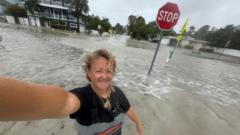Rising waters from Hurricane Helene had forced Briana Gagnier and her family to swim out of their home on Florida’s Gulf Coast.
Ms Gagnier, who lives in Holmes Beach north of Sarasota, had stayed behind with her family to protect their one-storey home, placing sandbags at every door and moving belongings on to tall furniture to keep them dry. They even used towels to try to stop the water from creeping in.
Then came a loud bang. Their garage door broke open violently – caving in to the powerful storm surge of Helene. Water quickly rose to their shoulders, forcing them to escape quickly.
“Everyone was screaming and panicking,” she told the BBC. “Whatever your worst idea of what this storm is – that is what we’re seeing.”
Ms Gagnier is one of many Floridians living along the state’s Big Bend Coast that are now reeling from the aftermath of Hurricane Helene, a powerful, deadly Category 4 hurricane that made landfall on Thursday evening, before weakening to a tropical storm as it churned inland.
Millions of households were without electricity on Friday morning across the south-eastern US and the storm has been blamed for several deaths in the region.
In some coastal areas, the storm surge was forecast to be up to 20ft (6m) – the size of a two-storey building.
At least one person was killed in Florida, authorities said, after a road sign fell on their car.
Two others died in Georgia, where the storm had brought a tornado that overturned a mobile home.
Footage from the aftermath of Helene shows flooded neighbourhoods and submerged cars, forcing multiple rescue operations of those who were left trapped from the storm, while locals described widespread devastation.
In one rescue, a man and his dog were saved by the US Coast Guard after his 36ft sailboat started taking on water.
The man, whom the Coast Guard did not name, was sailing 25 miles off the coast of Sanibel Island when he was caught by the hurricane. He called Channel 16 – the emergency channel for marine radios – to summon help.
On land, residents saw uncontrollable waters gushing into homes and businesses as the hurricane approached.
ML Ferguson, a resident of Anna Maria Island, told the BBC that the roads around had morphed into rivers.
When she returned to her home late on Thursday, she found it, too, had been flooded.
“Oh my gosh, it’s literally up to the second step,” she told the BBC in a phone interview, before quickly hanging up and rushing to stop more water from coming in.
After Ms Gagnier, the Holmes Beach resident, swam out of her home, she and her family ran across the street to a neighbour’s house, where they ended up rescuing two elderly people whose home had burst into flames.
She said the cause was unclear, but it appeared to be related to a golf cart battery.
Looking around, she said she saw couches, chairs, a bench and even a car float by. The water was above her mailbox for part of the evening, she added.
“I just can’t believe this is real. The eye of the storm didn’t even hit us straight on,” said Ms Gagnier. “This island is completely devastated. Everywhere I look, devastation.”
In Tallahassee, Florida, some residents like Cainnon Gregg had hunkered down to ride out the storm. Mr Gregg, who stayed at a friend’s shelter, said he wanted to remain close to the water to check on his oyster farm as soon as it was safe to do so.
He had spent the last few days trying to protect it by sinking it into the ocean bed. His farm was once destroyed before, during Hurricane Michael – a category five hurricane that hit the Florida panhandle in 2018 – and he said he was determined to learn from that lesson.
“Hopefully, and nothing is for certain, the farm is sitting nice and safe on the bottom,” he said ahead of the storm. “But anything could happen.”

